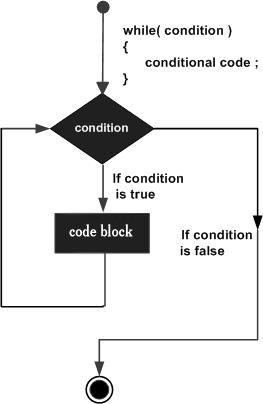In C, while is one of the keywords with which we can form loops. The while loop is one of the most frequently used types of loops in C. The other looping keywords in C are for and do-while.
The while loop is often called the entry verified loop, whereas the do-while loop is an exit verified loop. The for loop, on the other hand, is an automatic loop.
Syntax of C while Loop
The syntax of constructing a while loop is as follows −
while(expression){statement(s);}The while keyword is followed by a parenthesis, in which there should be a Boolean expression. Followed by the parenthesis, there is a block of statements inside the curly brackets.
Flowchart of C while Loop
The following flowchart represents how the while loop works −

How while Loop Works in C?
The C compiler evaluates the expression. If the expression is true, the code block that follows, will be executed. If the expression is false, the compiler ignores the block next to the while keyword, and proceeds to the immediately next statement after the block.
Since the expression that controls the loop is tested before the program enters the loop, the while loop is called the entry verified loop. Here, the key point to note is that a while loop might not execute at all if the condition is found to be not true at the very first instance itself.
The while keyword implies that the compiler continues to execute the ensuing block as long as the expression is true. The condition sits at the top of the looping construct. After each iteration, the condition is tested. If found to be true, the compiler performs the next iteration. As soon as the expression is found to be false, the loop body will be skipped and the first statement after the while loop will be executed.
Example of while Loop in C
The following program prints the “Hello World” message five times.
#include <stdio.h>intmain(){// local variable definitionint a =1;// while loop executionwhile(a <=5){printf("Hello World \n");
a++;}printf("End of loop");return0;}Output
Here, the while loop acts as a counted loop. Run the code and check its output −
Hello World
Hello World
Hello World
Hello World
Hello World
End of loop
Example Explanation
The variable “a” that controls the number of repetitions is initialized to 1, before the while statement. Since the condition “a <= 5” is true, the program enters the loop, prints the message, increments “a” by 1, and goes back to the top of the loop.
In the next iteration, “a” is 2, hence the condition is still true, hence the loop repeats again, and continues till the condition turns false. The loop stops repeating, and the program control goes to the step after the block.
Now, change the initial value of “a” to 10 and run the code again. Now the output will show the following −
End of loop
This is because the condition before the while keyword is false in the very first iteration itself, hence the block is not repeated.
A “char” variable represents a character corresponding to its ASCII value. Hence, it can be incremented. Hence, we increment the value of the variable from “a” till it reaches “z”.
Using while as Conditional Loop
You can use a while loop as a conditional loop where the loop will be executed till the given condition is satisfied.
Example
In this example, the while loop is used as a conditional loop. The loop continues to repeat till the input received is non-negative.
#include <stdio.h>intmain(){// local variable definition char choice ='a';int x =0;// while loop executionwhile(x >=0){(x %2==0)?printf("%d is Even \n", x):printf("%d is Odd \n", x);printf("\n Enter a positive number: ");scanf("%d",&x);}printf("\n End of loop");return0;}Output
Run the code and check its output −
0 is Even
Enter a positive number: 12
12 is Even
Enter a positive number: 25
25 is Odd
Enter a positive number: -1
End of loop
While Loop with break and continue
In all the examples above, the while loop is designed to repeat for a number of times, or till a certain condition is found. C has break and continue statements to control the loop. These keywords can be used inside the while loop.
Example
The break statement causes a loop to terminate −
while(expr){......if(condition)break;...}Example
The continue statement makes a loop repeat from the beginning −
while(expr){......if(condition)continue;...}More Examples of C while Loop
Example: Printing Lowercase Alphabets
The following program prints all the lowercase alphabets with the help of a while loop.
#include <stdio.h>intmain(){// local variable definitionchar a ='a';// while loop executionwhile(a <='z'){printf("%c", a);
a++;}printf("\n End of loop");return0;}Output
Run the code and check its output −
abcdefghijklmnopqrstuvwxyz
End of loop
Example: Equate Two Variables
In the code given below, we have two variables “a” and “b” initialized to 10 and 0, respectively. Inside the loop, “b” is decremented and “a” is incremented on each iteration. The loop is designed to repeat till “a” and “b” are not equal. The loop ends when both reach 5.
#include <stdio.h>intmain(){// local variable definitionint a =10, b =0;// while loop executionwhile(a != b){
a--;
b++;printf("a: %d b: %d\n", a,b);}printf("\n End of loop");return0;}Output
When you run this code, it will produce the following output −
a: 9 b: 1
a: 8 b: 2
a: 7 b: 3
a: 6 b: 4
a: 5 b: 5
End of loop
while Vs. do while Loops
The do-while loop appears similar to the while loop in most cases, although there is a difference in its syntax. The do-while is called the exit verified loop. In some cases, their behaviour is different. Difference between while and do-while loop is explained in the do-while chapter of this tutorial.
Leave a Reply